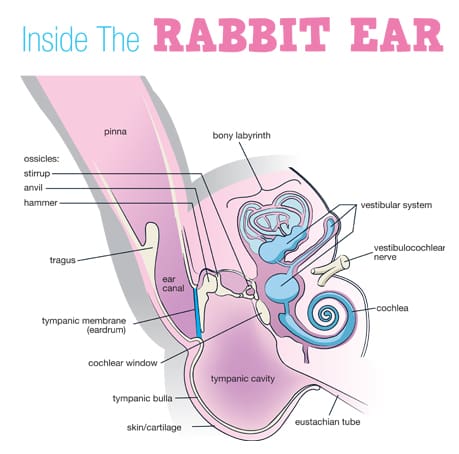Rabbits have big ears but it doesn’t mean that they can always hear well…

Your rabbit has been diagnosed with bacterial middle ear disease (otitis media). What is this?
Inflammation and bone infection (osteomyelitis) of the middle ear caused by the spread of bacteria from the upper respiratory tract and in some cases through the tympanic membrane.

What are the signs?
Being a prey species most rabbits show no outward signs at all. Some may shake their head or paw at the affected ear. Some develop a head tilt and may even lean, fall, or roll toward the affected side. Also with active otitis media they cannot hear on the affected side(s). Most of the time what we observe is that the rabbit spends an unusual amount of time in the litter box, a comfortable and familiar place.
How do we diagnose otitis media in rabbits?
We usually diagnose it during wellness visits using a video otoscope to evaluate the ear. If the infection is bulging or has ruptured the ear drum we are able to see it. The next step is to do a CT scan of the head to confirm and evaluate the extent of the infection.

This patient presented with a history of chronic ear scratching and recently developed a head tilt. HD CT scan showed left-sided aggressive middle ear disease (tympanic bulla) with brain involvement (green arrows).
How do we treat it?
Medical management by itself is rarely successful. You can flush the ear with a safe solution like sterile saline or TrizEDTA. We usually prescribe antibiotics to try to prevent the infection from worsening or going into other organs. Otitis causes pain and inflammation so in most cases we also prescribe an analgesic.
Surgery is the only way to manage otitis media in rabbits. There are 2 procedures that we perform depending on the severity of the infection which is determined by the CT scan.
The first one is a Lateral or Partial Canal Ear Resection which is used in rabbits with early disease or those in which the tympanic bulla (middle ear bone) shows no gross changes from infection. We remove all or part of the lateral ear cartilage so we can gain access to the tympanic opening and flush the infection out. This requires flushing at home, which is relatively simple. In some cases the infection resolves but most require continuous care. One advantage of this procedure is that it carries minimal side effects and gives us better access to the site of infection if flare-ups occur in the future.
The second one involves different variations to remove the affected bone (Bulla Osteotomy). This one is reserved for cases in which the bone is severely affected which is determined by the CT Scan. This procedure carries higher complication rates.
A study in dogs showed complication rates of 64-72%, we don’t have that data on rabbits yet.
Complications can include:
– Facial nerve deficits, face paralysis
– Ocular problems, dry or droopy eye
– Vestibular signs, imbalance
– Wound complications, fluid accumulation, discharge, infection
– Horner syndrome
– Excessive bleeding during surgery
Are there any complications to long term otitis?
A chronic ear infection is painful and your bunny is probably deaf in that ear(s). The infection can actually spread to other parts of the body like the inner ear and brain and your rabbit may head tilt or roll on the ground permanently. It can also spread to any organ; we see it primarily as a kidney infection and they often present with urine staining on their skin or with a fever. Remember that most rabbits will show no signs of being in pain. This is why is so important to bring your bunny in for a “Wellness” visit.
Treatment of rabbit ear disease can be challenging, our team will guide you through options to keep your bunny healthy and pain-free.If you have any further questions please do not hesitate to call us. Click here to read our brief article on the surgical procedure.

About Us
Our exotic animal hospital is dedicated exclusively to the care of birds, exotic small mammals, reptiles, and even fish! We can offer everything your pet needs for a healthy and happy life, from wellness care and grooming to diagnostics and dentistry, but we can also provide emergency care during our opening hours, along with more specialized treatment for referred patients.
